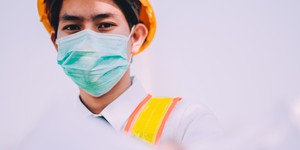Be Seen In the Dark
Summary
Introduction
Being outside in the evening can be relaxing as well as exciting and fun, but it could also be dangerous. Did you know that in 2014, on average, 13 pedestrians died on American roads every day and three out of every four pedestrian fatalities happened in poor light conditions, such as dusk, dawn, or at night? When considering these worrisome numbers, do you think the types of clothes worn could make a difference in how visible pedestrians are to drivers? If so, what should you wear: bright colors, fluorescent colors, or a safety vest with retro-reflective strips? This science activity will help you find out!
Background
You probably know that camouflage makes you blend into the background. Would wearing regular, non-camouflage materials be enough to make you more visible at night?
Humans can “see” because light that reflects off of objects reaches our eyes. Do some colors guide more light into our eyes so we can see them better? Brightly-colored objects reflect more light than dark-colored objects do. Fluorescent objects send out visible light when high-energy light shines onto them. Retro-reflective material—often referred to as reflective material—bounces back almost all of the light that shines onto it. Unfortunately, at night, there is little light available to bounce off of objects. In addition, typical nighttime light sources (headlights or street lights) rarely contain high-energy light, the type that makes fluorescent objects so bright in daylight. Would the scarce light reflected from a retro-reflective object make the object stand out against a dark background at night?
In this science activity, you will put three different “colors” (bright, fluorescent and retro-reflective) to the test. Which one do you think will increase visibility most in poor light conditions?
Materials
- Black or dark clothing to cover most of the body
- Brightly-colored garment or item
- Fluorescent garment or item
- Reflector or item equipped with retro-reflective tape
- Car
- Spot where you can park a car, and where there is a safe, open space of at least straight ahead. Preferably, find a space with little or no street light or other lighting after dark, and minimal traffic.
- Flashlights
- Adult assistant to operate the car and supervise any activities outside after dark
- Assistant to run the test; this can be the adult supervising you and operating the car
Preparation
- Whenever you are out after dark, observe what you can see, and what is hidden until it is near you. Use these observations to make a hypothesis of which “color” will most increase the visibility of a pedestrian.
- Before you go out after dark to perform the test, dress in black or a dark color. Ask your assistant(s) to do the same. Take your three items or garments and at least two flashlights with you to the test place.
Instructions
- Park the car. Leave the low beam lights on.
- During the test, the observer will sit in the car and rate how well a pedestrian is visible on a scale of 0 (not visible) to 10 (highly visible). Note that several people can be in the car and observe. At least one other person—the assistant—will walk out to about 100 meters straight ahead of the car. Once there, he or she will produce a short on-off flashlight light signal, signaling to the observer it is time to rate the visibility. The observer will rate the visibility of this “color” and signal back (again, a short on-off flashlight light signal) when he/she is done. The assistant can then take out a different colored item and signal it is time to rate the visibility of that “color”. This will go on until all colors: dark, brightly-colored, fluorescent, and retro-reflective are rated for their visibility.
- Before you start the experiment, state what you expect. Will one “color” be way more visible from 100 meters? If so, why do you think this will be the case?
- Perform the test. Do the results surprise you?
- Do you think the observations depend on the person observing? To find out, switch roles. The assistant will now sit in the car and observe and another person will walk out with the items to be tested.
- Compare the ratings of the different observers. Do all agree that specific “colors” are more visible than others? Do they agree on which “colors” are most visible?
- Is the difference in visibility of the different colors tiny, medium or huge? Can you find a reason why a color increases visibility at night?
- Was your expectation correct? Are you surprised about the results?
Extra: In this test, you rate the visibility of pedestrians placed 100 meters straight ahead of the car. Do you expect the results to be valid at shorter or farther distances? Perform the test to find out!
Extra: Ponder what else a pedestrian could do to increase his/her visibility at night. Can you test these solutions in a similar way and compare these results to the ones you obtained in this activity? Did it increase visibility more, way more or less?
Extra: Do you think pedestrians can accurately estimate how visible they are at night? To find out, ask people if they think a driver in a car with low beam headlights on can see them from 100 meters if they are dressed in the specific colors you tested. Compare their estimates to the test results you obtained.
Observations and Results
Did you notice how much the retro-reflective materials aid visibility in the test circumstances? This is to be expected.
Although bright colors bounce off more light than dark colors do, the difference is not enough to make a pedestrian visible at night from a car parked 100 meters down the road, even when the car has its headlights on. Putting on a fluorescent-colored item might help a little, as fluorescent colors send out visible light when high energy light shines on them. Street lights and car headlights usually do not contain much high-energy light; this little bit slightly increases the visibility, which might have made the pedestrian faintly visible in your test. This visibility was probably tiny compared to the visibility of a pedestrian equipped with retro-reflectors. Reflectors are very efficient at reflecting the light back and into your eyes, and can drastically improve visibility at night.
As you decrease the distance between the car and the pedestrian, the visibility of each of the colors increases. Still, at any distance, the retro-reflective material wins the visibility contest.
Most pedestrians overestimate their visibility on the road after dark sets in. They often correctly indicate retro-reflective clothing increases their visibility, but underestimate its effectiveness.
Ask an Expert
Additional Resources
- Improving Visibility at Night by Wearing Night Clothing with High Visibility, from 3M Scotchlite
- Driving Safety, Pedestrians, from National Highway Traffic Safety Administration
- Reflector Education, from the Reflectory
- Fluorescence, from Kids.Net.Au Encyclopedia








